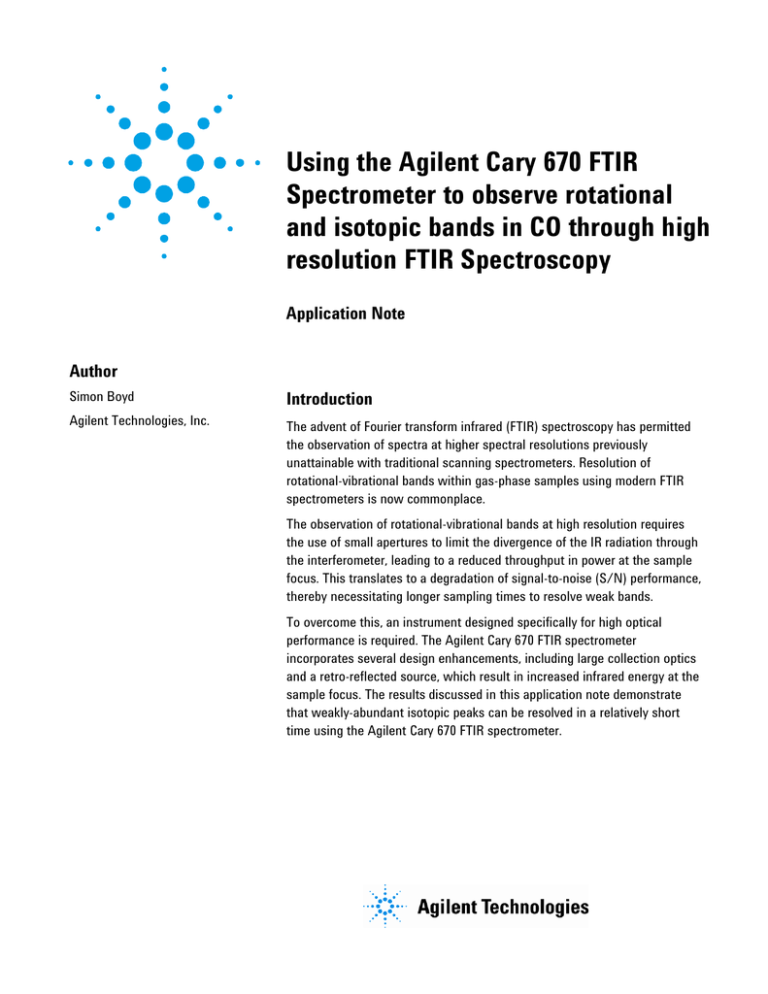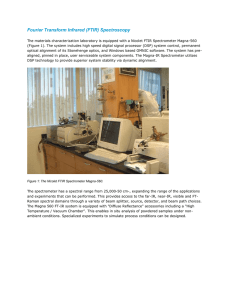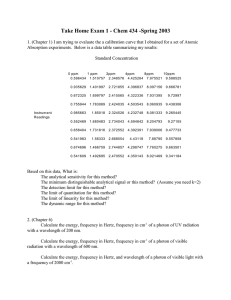Application Note
advertisement

Using the Agilent Cary 670 FTIR Spectrometer to observe rotational and isotopic bands in CO through high resolution FTIR Spectroscopy Application Note Author Simon Boyd Introduction Agilent Technologies, Inc. The advent of Fourier transform infrared (FTIR) spectroscopy has permitted the observation of spectra at higher spectral resolutions previously unattainable with traditional scanning spectrometers. Resolution of rotational-vibrational bands within gas-phase samples using modern FTIR spectrometers is now commonplace. The observation of rotational-vibrational bands at high resolution requires the use of small apertures to limit the divergence of the IR radiation through the interferometer, leading to a reduced throughput in power at the sample focus. This translates to a degradation of signal-to-noise (S/N) performance, thereby necessitating longer sampling times to resolve weak bands. To overcome this, an instrument designed specifically for high optical performance is required. The Agilent Cary 670 FTIR spectrometer incorporates several design enhancements, including large collection optics and a retro-reflected source, which result in increased infrared energy at the sample focus. The results discussed in this application note demonstrate that weakly-abundant isotopic peaks can be resolved in a relatively short time using the Agilent Cary 670 FTIR spectrometer. Instrumentation An Agilent Cary 670 FTIR spectrometer was used for all measurements with the settings listed in Table 1. The instrument was purged with nitrogen prior to spectral collection. Table 1. Instrument parameters in Resolutions Pro software used in all collections Instrument Parameters Settings MCT narrow band Speed (kHz) Filter (kHz) 25.0 17.4 Source MIR Normal Collection Sample scans Background scans Resolution (cm-1) Aperture (cm-1) Symmetry 4 4 0.09 0.10 asym Computation Apodisation type Zero filling factor UDR boxcar 16 2 Detector Figure 1. Sample spectrum displayed between 2250–2000 cm-1 revealing the P (right) and R (left) branching of the C≡O stretching band centered at 2143.3 cm-1 These bands are due to transitions of the C12O16 isotopomer. Atmospheric carbon monoxide is known to contain the isotopomers C13O16 and C12O18 at abundances of 1.1% and 0.2% respectively. The frequency of the fundamental transition, ν0 →ν 1, ΔJ=0 of these isotopomers is given by the ratio of the bond strength for the C≡O bond, k, and the reduced mass, µ, of the molecule (Equation 1 below). Materials and reagents v A carbon monoxide cell (KBr windows, 10 cm path length) was obtained from Pike Technologies, Madison WI, USA. The cell contains carbon monoxide at a reduced pressure of 4 Torr to ensure that the resolution of the obtained spectra are instrument-limited and not physically limited by the sample. The cell was mounted on the slide-on sample holder and placed in the left hand side position of the sample compartment to account for the extra length of the gas cell. 1 2 k (1) The reduced mass of the various isotopomers of this molecule are given by: m1m2 m1m2 (2) where m1 and m2 are the atomic masses of each atom. The fundamental frequency of the ν0 →ν 1 transition in the C12O16 molecule1 is 2143.3 cm-1, while those of the other isotopomers can be estimated by considering the ratio of their reduced masses with C12O16 (as given by Equation 3 below). Results and discussion Isotopomers of carbon monoxide Sample spectra were recorded (Figure 1) and the region between 2250–2000 cm-1 analyzed to reveal the rotational-vibrational transitions of the C≡O stretching band centered at 2143.3 cm-1. These transitions are grouped into two branches reflecting a simultaneous rotational transition: the lower energy P-branch where the change in rotational state (ΔJ) = -1, and the higher energy R-branch where ΔJ=1. va vb ub ua (3) Using the above equations, the fundamental frequency of the ν0 →ν 1 transition can be calculated for each isotopomer. 2 require a large number of co-additions in order to average out noise within the spectrum. Table 2. Calculated fundamental frequency for the isotopomers of C≡O (cm-1) Reduced Mass C12O16 6.8571 2143.3 C13O16 7.1724 2095.7 C12O18 7.2000 2092.1 Due to its superior optical design, the Agilent Cary 670 FTIR delivers excellent signal-to-noise performance even at very high spectral resolutions and facilitates fast analysis of weak bands with a high degree of precision and accuracy. By focusing on the region between 2170 and 2095 cm-1 (as highlighted in Figure 2), the R branch of C13O16 is clearly visible extending right to left from the forbidden ∆J=0 transition centered at 2095.7 cm-1. Spectra recorded in this study were collected with just 4 scans which correlate to a 40 second collection time. The high throughput and performance are attributable to a number of design features including: Figure 2. Spectrum of C≡O between 2170–2095 cm-1 highlighting the fine detail of the R branches of C13O16 57 mm optics that ensure a larger collection area A novel source with retro-reflector to ensure the collection of a greater portion of the source’s output An AC-powered source to prevent the wandering of the hot spot within the source and to ensure that perfect alignment of the source is maintained. All of these factors combine to deliver more power to the sample focus translating to better S/N performance. In addition, the frictionless air-bearing interferometer and dynamic alignment system of the Agilent Cary 670 FTIR spectrometer deliver superb velocity control of the moving mirror. This leads to superior wavelength precision and accuracy and permits faster collection times, especially at higher spectral resolutions. Figure 3 exhibits some visually discernable differences between the transitions of C12O18 and the other isotopomers of carbon monoxide. The most intense of these is C13O16 (at 2114.0 cm-1) followed by C12O18 (at 2113.4 cm-1) reflecting the natural abundances of these isotopomers within atmospheric carbon monoxide. Wavelength resolution, accuracy and precision The wavelength resolution, accuracy and precision values reported in Table 3 were determined. From three replicate collections of carbon monoxide using the collection parameters outlined in Table 1. The wavelength resolution, accuracy and precision of the spectrometer was calculated based on the R-5, R-6 and R-7 transitions of C12O16 in the C≡O spectra. Figure 3. Expanded view of the same spectrum of carbon monoxide between 2117 and 2109 cm-1, illustrating transitions of the C12O16, C13O16 and C12O18 isotopomers The observation of the peaks from the weakly abundant species requires good S/N performance at high resolution. Typically, resolution of these peaks would 3 Table 3. Wavenumber accuracy, precision and spectral resolution results for the Agilent Cary 670 FTIR spectrometer using the R-5, R-6 and R-7 transitions of C12O16 wavenumber reference 2 (cm-1) wavenumber actual (cm-1) precision (st dev) (cm-1) resolution (cm-1) R-5 2165.6010 2165.6010 0.0016 0.0572 R-6 2169.1979 2169.1986 0.0010 0.0598 R-7 2172.7588 2172.7586 0.0008 0.0552 R-5 2165.6010 2165.6010 0.0016 0.0572 Figure 4. Spectra of three replicates of the R-6 transition of C12O16. Such spectra were used to calculate the wavelength precision, accuracy and resolution of the Agilent Cary 670 FTIR spectrometer The wavelength of maximum absorption for each of the R-5, R-6 and R-7 transitions was calculated using the mean of the three replicate scans of carbon monoxide. These were compared with reference values from the HITRAN database2 to assess the wavelength accuracy of the spectrometer. All three transitions were found to lie within 0.001 cm-1 of reference values, highlighting the superior performance of the Agilent Cary 670 FTIR spectrometer. Conclusion The rotational structure of the C≡O stretching band centered at 2143.3 cm-1 was observed with <0.06 cm-1 spectral resolution for the R-5, R-6 and R-7 transitions. Isotopic splitting of the stretching band was also observed, with the isotopomers C13O16 and C12O18 being resolved with just a 40 second collect reflecting the high optical performance of the Agilent Cary 670 FTIR spectrometer. The spectrometer’s wavelength accuracy was determined to be better than 0.001 cm-1 against reference values, while the precision was found to be better than 0.001 cm-1. These performance attributes are the result of a number of design features which have been incorporated into the Agilent Cary 670 FTIR spectrometer and demonstrate the suitability of the instrument for high resolution gas phase applications. Also calculated was the wavelength precision of the spectrometer, defined as the standard deviation of the peak wavelength from the mean of the three replicate scans. This was determined for each of the R-5, R-6 and R-7 transitions. In each case the precision was found to be better than 0.001 cm-1 again demonstrating the stability and performance of the Agilent Cary 670 FTIR spectrometer. The instrument-limited spectral resolution was determined by calculating the full width at half maximum (FWHM) for each of the three transitions as illustrated in Figure 4. The resolution of the absorbance bands was determined to be better than 0.06 cm-1 for each transition, hence enabling well-resolved observation of rotational structure within gaseous samples. References 1. Rao, K.N. and Mathews, C.W., editors, Molecular Spectroscopy: Modern Research, Academic Press, New York, 1972. 2. Rothman L.S. et al. 2004. The HITRAN 2004 molecular spectroscopic database. J. Quantitative Spectroscopy & Radiative Transfer, 96(2): 241-250. 4 This page is intentionally left blank. 5 www.agilent.com/chem © Agilent Technologies, Inc., 2008, 2011 Published March, 2011 Publication Number si-01378 .

